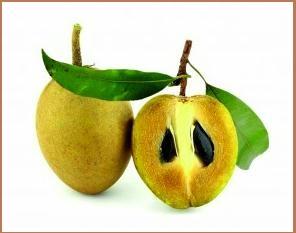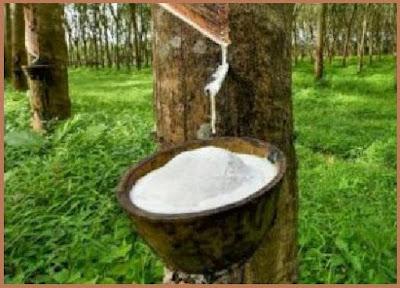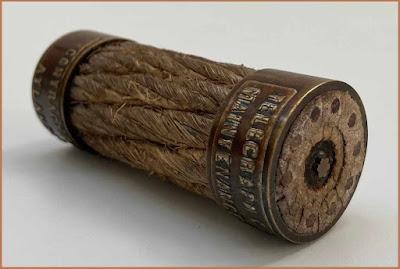The word actually comes from the Malay. Getah translates as latex. Percha Island is an older name for Sumatra and Perca is described as a tree which is 5–30 metres tall and up to 1 m in trunk diameter. The leaves are evergreen, alternate or spirally arranged, simple, entire, 8–25 long, glossy green above, and often yellow or glaucous below. The flowers are produced in small clusters along the stems, each flower with a white corolla with four to seven (mostly six) acute lobes. The fruit is an ovoid 3–7 cm berry, containing one to four seeds; in many species, the fruit is edible.

gutta-percha fruit
Long before Gutta-percha was introduced into the Western world, it was used in a less processed form by the natives of the Malaysian archipelago for making knife handles, walking sticks, and other purposes. The first European to discover this material was John Tradescant, who collected it in the far east in 1656. He named this material "Mazer wood". William Montgomerie, a medical officer in imperial service, introduced gutta-percha into practical use in the West. He was the first to appreciate the potential of this material in medicine, and he was awarded the gold medal by the Royal Society of Arts, London in 1843.
tapping trees for latex
Scientifically classified in 1843, it was found to be a useful natural thermoplastic. In 1851, 30,000 long cwt (1,500,000 kg) of gutta-percha was imported into Britain. During the second half of the 19th century, gutta-percha was used for many domestic and industrial purposes such as furniture, golf balls, jewelry, pistol grip handles, canes and walking sticks and it became a household word. Today it is still used in Dentistry but as I’m having a crown fitted next month I’d like to look at its use in the following.Gutta-percha had properties such as its hard plasticity, electrical insulating properties and its extremely low coefficient of thermal expansion/contraction. It softened at easily attainable temperatures, was mouldable and flexible, was very stable and did not degrade in sea water so thus was particularly important for the manufacture of the first underwater telegraph cables. Indeed, I believe that Michael Faraday said he was gobsmacked by the stuff. There was no other material to match it in the 19th century.The Gutta Percha Company was established in 1845 and their industrial products included machinery belts, acid-tank linings, and tubes. The extrusion machinery used to make the tubes, modelled it is said on Italian pasta machines, was soon adapted for use in wire covering. This technique was used first to insulate landline cables, and later for submarine cables.
underwater cabling
After the failure of their first cable in 1850 they laid a successful submarine cable from Dover to Calais in 1851. This used two layers of gutta-percha insulation and an armoured outer layer. Previous attempts to use gutta-percha as cable insulation involved compressing two sheets of gutta-percha around the wire, but this left two seams in the insulation. The Gutta Percha Company's tubes were seamless. The conductors of the 1851 cable had an irregular coating of gutta-percha, which had to be shaved away in places, and suffered from air holes and voids. Nonetheless, the cable was a success, and much additional business followed.In the 20th century synthetic materials such as Bakelite and polyethylene have replaced gutta-percha.Who would have thought it? There is a poem about Gutta-percha which I've credited as Anon (I can't find the author anyway):
In Praise of Gutta Percha
(to the tune of Dainty Davie)
Of a' the changes that of late
Have shaken Europe's social state—
Let wondering politicians prate,
And 'bout them mak a wark a'—
A subject mair congenial here,
And dearer to a Golfer's ear
I sing—the change brought round last year
By balls of Gutta Percha!
Tho' Gouf be of our games most rare,
Yet truth to speak, the tear and wear
O' balls was felt to be severe,
And source o' great vexation;
When Gourlay's balls cost half-a-croun,
And Allan's no a farthing doun,
The feck o's wad been harried soon,
In this era of taxation.
But times are changed—we dinna care
Though we may ne'er drive leather mair,
Be't stuffed wi' feather or wi' hair—
For noo we're independent.
At last a substance we hae got,
Frae which for scarce mair than a groat,
A ba' comes that can row and stot—
A ba' the most transcendent.
Hail, Gutta Percha, precious gum!
O'er Scotland's links lang may ye bum;
Some purse-proud billies haw and hum,
And say ye're douf at fleein';
But let them try ye fairly out,
Wi' ony balls for days about,
Your merits they will loudly tout,
And own they hae been leein'.
And noo that a' your praise is spent,
Ye'll listen to a friend's comment,
And kindlier tak on wi' paint,
Then ye wad be perfection.
And sure some scientific loon,
On Golfing will bestow a boon,
And gie ye a cosmetic soon,
And brighten your complexion. AnonThanks for reading, Terry Q Email ThisBlogThis!Share to TwitterShare to Facebook
